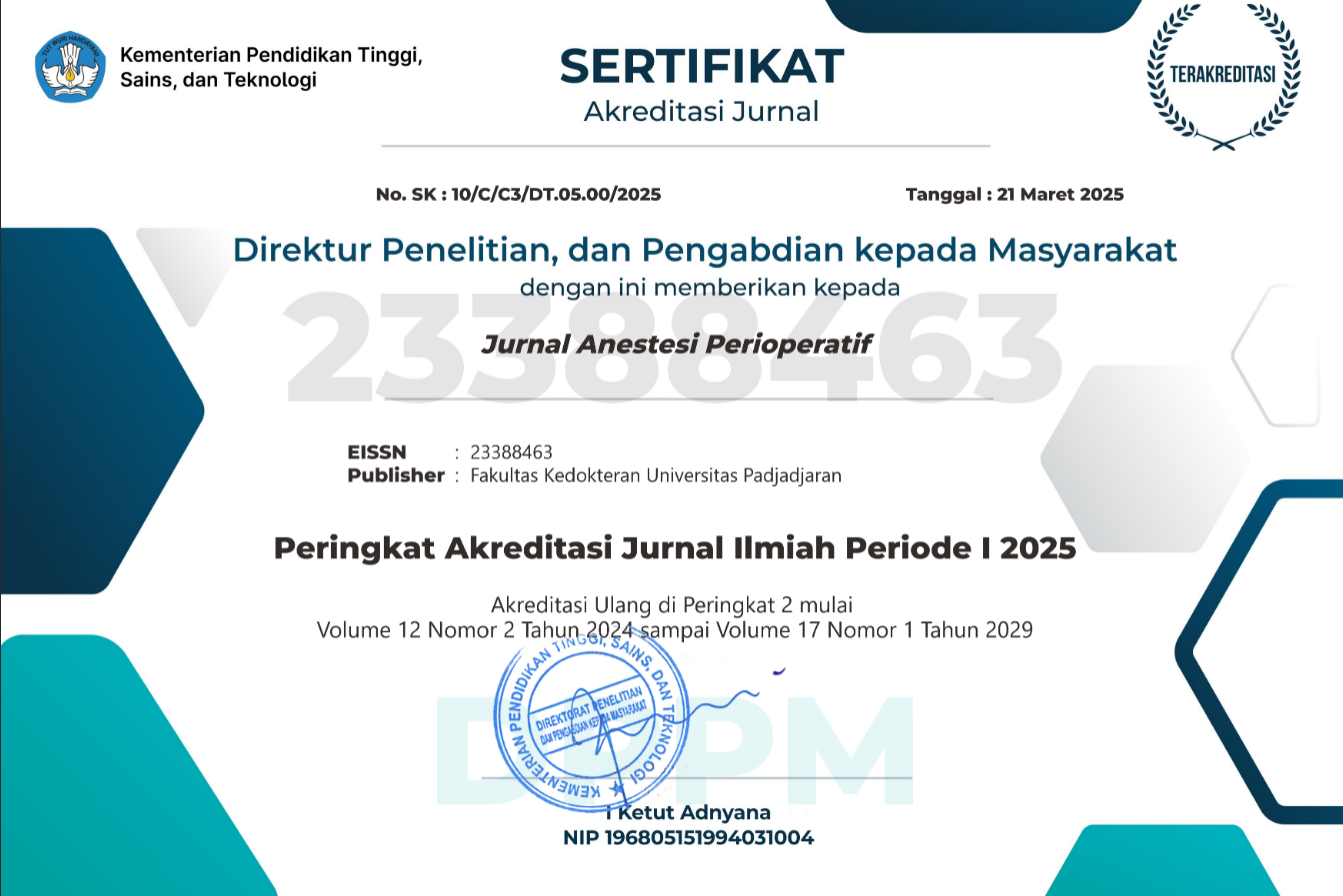Anestesi Kaudal pada Neonatus dengan Suspek Sindrom Down dan Hipotiroid Kongenital yang dilakukan Tindakan Anoplasi
Abstract
Dokter anestesi menghadapi beberapa tantangan dalam manajemen anestesi untuk neonatus yang menjalani operasi di bawah anestesi umum karena ketidakmatangan berbagai organ, toleransi terhadap agen anestesi, dan cadangan oksigen rendah. Tindakan regional neuroaksial kaudal dapat digunakan sebagai alternatif yang aman pada neonatus yang dilakukan tindakan anoplasti. Laporan kasus ini bertujuan memaparkan keberhasilan penatalaksanaan anestesi pada neonatus yang menjalani operasi anoplasti dengan anestesi kaudal. Seorang bayi baru lahir aterm dengan usia 3 hari dan BB 2.800 gram disertai dengan suspek sindrom Down dan hipotiroid kongenital dikonsulkan untuk menjalani anoplasti. Pada pemeriksaan fisis didapatkan wajah tampak mongolid dengan abdomen yang distensi dan produksi orogastric tube kehijauan sebanyak 10 mL. Pada preoperatif, pasien dipuasakan dan diberikan maintenance cairan. Operasi dilakukan dengan tindakan regional kaudal menggunakan bupivakain 0,25% sebanyak 0,5 mL/kgBB. Untuk menjaga pasien tetap tenang saat intraoperatif, pasien diberikan dot. Efektivitas blok diperiksa menggunakan tes pinprick di bawah umbilikal. Tidak diberikan sedasi saat intraoperasi. Saat intaoperasi didapatkan bayi tenang dan operasi dapat diselesaikan dengan baik. Tindakan kaudal anestesi pada anoplasti dapat dilakukan dengan aman terutma pada pasien neonatus yang memiliki risiko tinggi untuk dilakukan tindakan general anestesi.
Caudal Anesthesia for Anoplasty in Neonates with Suspected Down Syndrome and Congenital Hypothyroid
Anesthesiologists face several challenges in anesthetic management for neonates undergoing surgery under general anesthesia due to the immaturity of various organs, tolerance to anesthetic agents, and low oxygen reserves. Caudal anesthesia can be used as a safe alternative in neonates undergoing anoplasty. This case report aimed to describe the success of anesthetic management in neonates who underwent anoplasty surgery under caudal anesthesia. A term newborn baby aged three days and weighing 2800 grams with suspected Down syndrome and congenital hypothyroidism was consulted for anoplasty. On physical examination, the face appeared Mongolian, with a distended abdomen and ten ccs of greenish orogastric tube production. Preoperatively, the patient fasted and was given fluid maintenance. The operation was performed by caudal regional action using 0.25% bupivacaine as much as 0.5 mL/kgBW. The patient needed to be calm intraoperatively, so the patient was given a pacifier. The effectiveness of the block was checked using the pinprick test below the umbilical. No intraoperative sedation was given. At the intraoperative time, the baby was calm, and the operation was completed. Caudal anesthesia in anoplasty can be performed safely, especially in neonates who are at high risk for general anesthesia.
Keywords
Full Text:
PDFReferences
- Wiegele M, Marhofer P, Lönnqvist PA. Caudal epidural blocks in paediatric patients: a review and practical considerations. Br J Anaesth. 2019;122(4):509–17.
- Geze S, Imamoǧlu M, Cekic B. Awake caudal anesthesia for inguinal hernia operations: Successful use in low birth weight neonates. Anaesthesist. 2011;60(9):841–4.
- Cui Y, Wang Y, Cao R, Liu K, Huang QH, Liu B. On-table extubation in neonates undergoing anoplasty: an experience of anesthetic management on the concept of fast-tracking anesthesia: a pilot study. Medicine. 2019;98(2):1–5.
- Edler A, Wellis VG. Caudal epidural anesthesia for pediatric patients: a safe, reliable and effective method in developing countries. Updat Anaesth. 2003;(17):15–19.
- Congenital hypothyroidism. Dalam: Bissonnette B, Luginbuehl I, Marciniak B, Dalens BJ. Syndromes: rapid recognition and perioperative implications. New York: Edisi ke-1 McGraw Hill; 2006.
- Amr NH. Thyroid disorders in subjects with down syndrome: an update. Acta Biomed. 2018;89(1):132–9.
- Haque MI. Anesthesia for patients with down syndrome, Int J Health Sci Res. 2019;9(5):381–5.
- Shon YJ, Huh J, Kang SS, Bae SK, Kang RA, Kim DK. Comparison of saddle, lumbar epidural and caudal blocks on anal sphincter tone: A prospective, randomized study. J In Med Res. 2016;44(5): 1061–71.
DOI: https://doi.org/10.15851/jap.v10n2.3051
Article Metrics
Abstract view : 1288 timesPDF - 1187 times
This Journal indexed by

JAP is licensed under a Creative Commons Attribution-NonCommercial 4.0 International License
View My Stats



